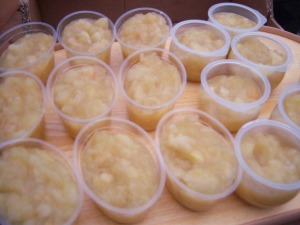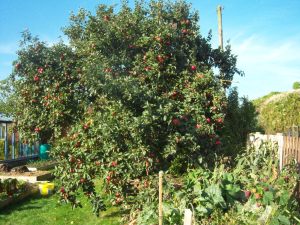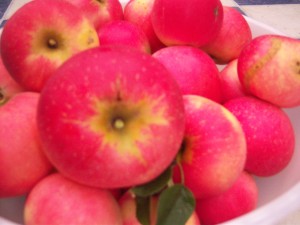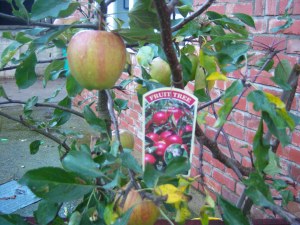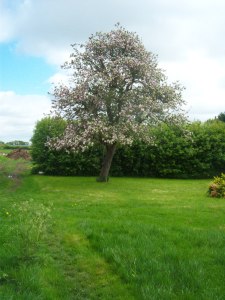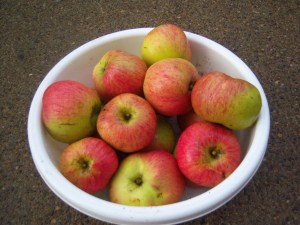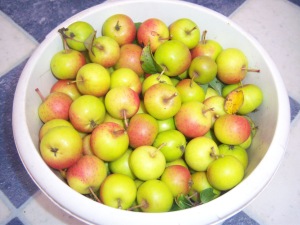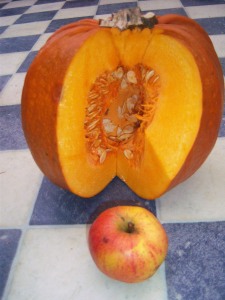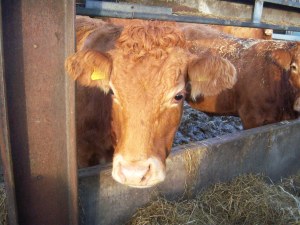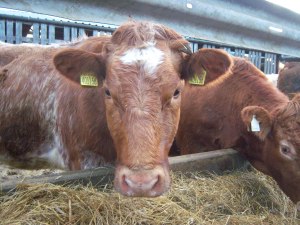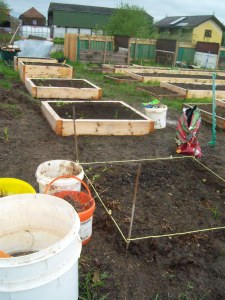2013 was a fantastic year for apples. I was obviously very impressed judging by the number of photos I took! At home we have an old tree in the garden with apples that ripen in August. They are a soft apple and won’t store (but they are lovely fresh or frozen in yogurt pots as apple sauce).
I took some of these apples to an RHS identification day where the expert, Jim Arbury, told me they were a variety called Bushey Grove (RHS award of merit 1922). I do have a little doubt over this as the information I’ve read says that they are harvested October to December but few remain on our tree by October. Also Auntie Dolly reckons the tree was planted before 1920 and the first ever Bushey Grove tree only fruited in 1910. Would it really have made it from Kent to a Yorkshire garden by 1920?
Anyway, whatever its name, we love the apples from this tree. With it ripening so early though, it is very popular with wasps. Our favourite eating apple tree, Discovery, is also early and plagued by wasps. However, knowing how fabulous a freshly picked Discovery is, I was tempted to buy three more bare rooted trees at a local sale last spring. I planted them in buckets for this year and let them carry one or two fruits each. They definitely weren’t Discovery! I took these to the expert too and he told me they were Jupiter (RHS award of merit 1993). I’m not disappointed though. They are nice sweet apples with the added bonus that they ripen much later – long after the wasps have gone for the year. I now have an extended eating apple season!
I now have an extended cooking apple season too. When I was told that this gorgeous tree at Village Farm was a Bramley Seedling I wasn’t very impressed – I’ve never been a fan of shop bought ones.
However, having so many other apples to deal with, the Bramleys were left untouched. They were still on the tree in November and I still have some keeping well just in a bowl now. They are delicious raw or cooked so don’t be put off by Bramleys picked far too early for commercial reasons – they are 100 times better when left to mature on the tree!
I’m sure that if I’d picked more back in November and stored them correctly, they would last a lot longer. Aunty Dolly recommends storing a few in plastic bags in a cold outbuilding, putting pin pricks in the bags so the apples don’t sweat. The advantage of this over wrapping them in newspaper is that you can instantly see if any are going bad and remove them.
It was also a good year for wild crab apples. I made this bowlful into chilli jelly. I made some into a mint jelly too but next year that experiment will need more mint!
The thing with all these apple sauces and jellies though, is the amount of sugar needed to preserve them. I cut it down in the chilli jelly recipe but then it needed a lot longer on the boil to achieve a set. We did juice quite a lot of eaters and froze some to drink later. That was lovely without any added sweetness. My friend Judy makes wonderful apple crisps in her dehydrator. The variety she used didn’t need any sugar and were absolutely delicious. I’m looking out for a second hand one so that I can trial my varieties dried. Seems we need electricity to either prepare or store most apples!

